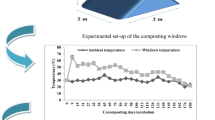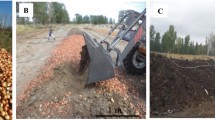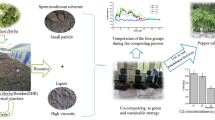Abstract
Starting from polluting waste, such as those produced by the olive oil industry, composting is able to produce stable organic materials that can be suggested as peat surrogate in the preparation of growth media for potted plants. In this work stable and mature olive mill waste compost (OMWC) was produced by using a simplified novel static composting procedure conducted in gas permeable bags. In order to predict its nutritional and suppressive potential, physico-chemical and biological characteristics of OMWC were investigated as well as its performance when used instead of peat in the preparation of growth media for Photinia fraseri cv. “Red Robin” potted plants. The innovative composting technique showed to be fully comparable to conventional methods of aerobic composting and able to convert OMWs into well-humified, stable, mature and rich in nutrients amendment. OMWC was colonized by different fungal species belonging to the genus Aspergillus and Penicillium that showed an appreciable suppressive potential against Sclerotinia sclerotiorum and Phytophthora cactorum. OMWC also resulted suitable for nursery cultivation of P. fraseri, showing the best performance when used at 33 and 66% peat substitution rate. The recycling method proposed represents a virtuous and low cost model for proper and successful management of olive mill waste.
Graphical Abstract








Similar content being viewed by others
References
Abad, M., Noguera, P., Burés, S.: National inventory of organic wastes for use as growing media for ornamental potted plant production: case study in Spain. Bioresource Technol. 77, 197–200 (2001)
Adani, F., Confalonieri, R., Tambone, F.: Dynamic respiration index as a descriptor of the biological stability of organic wastes. J. Environ. Qual. 33, 1866–1876 (2004)
Adav, S.S., Ravindran, A., Sze, S.K.: Quantitative proteomic study of Aspergillus fumigatus secretome revealed deamidation of secretory enzymes. J. Proteomics. 119, 154–168 (2015)
Aleandri, M.P., Chilosi, G., Muganu, M., Vettraino, A., Marinari, S., Paolocci, M., Vannini, A.: On farm production of compost from nursery green residues and its use to reduce peat for the production of olive pot plants. Sci. Hortic. 193, 301–307 (2015)
Aleandri, M.P., Chilosi, G., Bruni, N., Tomassini, A., Vettraino, A., Vannini, A.: Use of nursery potting mixes amended with local Trichoderma strains with multiple complementary mechanisms to control soil-borne diseases. Crop Prot. 67, 269–278 (2015)
Alfano, G., Lustrato, G., Lima, G., Vitullo, D., Ranalli, G.: Characterization of composted olive mill wastes to predict potential plant disease suppressiveness. Biol. Control. 58, 199–207 (2011)
Altieri, R., Esposito, A.: Olive orchard amended with two experimental olive mill wastes mixtures: effects on soil organic carbon, plant growth and yield. Bioresource Technol. 99, 8390–8393 (2008)
Altieri, R., Esposito, A., Parati, F., Lobianco, A., Pepi, M.: Performance of olive mill solid waste as a constituent of the substrate in commercial cultivation of Agaricus bisporus. Int. Biodeter. Biodegr. 63(8), 993–997 (2009)
Altieri, R., Esposito, A.: Evaluation of the fertilizing effect of olive mill waste compost in short-term crops. Int. Biodeterior. Biodegradation. 64, 124–128 (2010)
Altieri R., Esposito A., Baruzzi G.: Use of olive mill waste mix as peat surrogate in substrate for strawberry soilless cultivation. Int. Biodeter. Biodegr. 64, 670–675 (2010)
Altieri R., Esposito A., Nair T.: Novel static composting method for bioremediation of olive mill waste. Int. Biodeter. Biodegr. 65, 786–789 (2011)
Altieri R., Esposito A., Baruzzi G., Nair T.: Corroboration for the successful application of humified olive mill waste compost in soilless cultivation of strawberry. Int. Biodeter. Biodegr. 88, 118–124 (2014)
Anastasi A, Varese GC, Voyron S, Scannerini S, Filipello Marchisio V: Characterization of fungal biodiversity in compost and vermicompost. Comp. Sci. Util. 12, 185–191 (2004)
Anastasi, A., Varese, G.C., Marchisio, V.F.: Isolation and identification of fungal communities in compost and vermicompost. Mycologia. 97, 33–44 (2005)
Avilés, M., Borrero, C., Trillas, M.I.: Review on compost as an inducer of disease suppression in plants grown in soilless culture. Dyn. Soil, Dyn. Plant 5, 1–11 (2011)
Boldrin A., Hartling K. R., Laugen M., Christensen T.H.: Environmental inventory modelling of the use of compost and peat in growth media preparation. Resour. Conserv. Recy. 54, 1250–1260 (2010)
Bonanomi, G., Antignani, V., Capodilupo, M., Scala, F.: Identifying the characteristics of organic soil amendments that suppress soilborne plant diseases. Soil Biol. Biochem. 42, 136–144 (2010)
Chowdhury, A.K.M.M.B., Akratos, C.S., Vayenas, D.V., Pavlou, S.: Olive mill waste composting: a review. Int. Biodeter. Biodegr. 85, 108–119 (2013)
DI.VA.P.R.A. (DIpartimento di VAlorizzazione e Protezione delle Risorse Agro-forestali, Sez. Chimica Agraria, Università di Torino) and I.P.L.A. (Istituto per le Piante da Legno e l’Ambiente): Metodi di analisi dei compost–Determinazioni chimiche, fisiche, biologiche. Analisi merceologica dei rifiuti. Assessorato all’Ambiente Regione Piemonte Eds, Torino, IT (1992)
DL 75 2010: Decreto Legislativo 29 aprile 2010, n. 75 of Italian Republic ‘‘Riordino e revisione della disciplina in materia di fertilizzanti’’, a norma dell’articolo 13 della Legge 7 luglio 2009 n.88, GazzettaUfficiale n. 121 - Supplemento Ordinario n.106, Roma, May 26th (2010)
Elsharkawy, M.M., Shimizu, M., Takahashi, H., Hyakumachi, M.: Induction of systemic resistance against Cucumber Mosaic Virus by Penicillium simplicissimum GP17-2 in Arabidopsis and tobacco. Plant Pathol. 61, 964–976 (2012)
Favoino, E., Hogg, D.: The potential role of compost in reducing greenhouse gases. Waste Manage. Res. 26, 61–69 (2008)
Franceschini, S., Chitarra, W., Pugliese, M., Gisi, U., Garibaldi, A., Lodovica Gullino, M.: Quantification of Aspergillus fumigatus and enteric bacteria in European compost and biochar. Compost Sci. Util. 24, 20–29 (2016)
Glass, N. L., Donaldson, G. C.: Development of primer sets designed for use with the PCR to amplify conserved genes from filamentous ascomycetes. Appl. Environ. Microb. 61, 1323–1330 (1995)
Gravel, V., Martinez, C., Antoun, H., Tweddell, R.J.: Antagonist microorganisms with the ability to control Pythium damping-off of tomato seeds in rockwool. Biocontrol. 50, 771–786 (2005)
Haung, R.T.: The Practical Handbook of Compost Engineering. Lewis Publishers, Boca Raton (1993)
Hieno, A., Ara Naznin, H., Hyakumachi, M., Higuchi-Takeuchi, M., Matsui, M., Yamamoto, Y.Y.: Possible involvement of MYB44-mediated stomatal regulation in systemic resistance induced by Penicillium simplicissimum GP17-2 in Arabidopsis. Microbes and Environments advance publication doi:10.1264/jsme2.ME16025 (2016)
Hoitink, H.A.J., Krause, M.S., Han, D.Y.: Spectrum and mechanisms of plant disease control with composts. In: Stoffela, P.J., Kahn, B.A. (eds.) Compost Utilization in Horticultural Cropping Systems, pp. 263–273. Lewis, Boca Raton (2001)
Hossain, M.M., Sultana, F., Kubota, M., Koyama, H., Hyakumachi, M.: The plant growth-promoting fungus Penicillium simplicissimum GP17-2 induces resistance in Arabidopsis thaliana by activation of multiple defense signals. Plant Cell Physiol. 48, 1724–1736 (2007)
Isidori, M., Lavorgna, M., Nardelli, A., Parrella, A.: Model study on the effect of 15 phenolic olive mill wastewater constituents on seed germination and Vibrio fischeri metabolism. J. Agr. Food Chem. 53, 8414–8417 (2005)
Kim, C., Jung, H., Kim, Y. O., Shin, C.S.: Antimicrobial activities of amino acid derivatives of Monascus pigments. FEMS Microbiol. Lett. 264, 117–124 (2006)
Koike, N., Hyakumachi, M., Kageyama, K., Tsuyumu, S., Doke, N.: Induction of systemic resistance in cucumber against several diseases by plant growth-promoting fungi: lignification and superoxide generation. Eur. J. Plant Pathol. 107, 523–533 (2001)
Kück, U., Bloemendal, S., Teichert, I.: Putting fungi to work: harvesting a cornucopia of drugs, toxins, and antibiotics. PLoS Pathog. 10, e1003950 (2014)
Lasardi, K.E., Stentiford, E.I.: A simple respirometric technique for assessing compost stability. Water Res. 32, 3717–3723 (1998)
Morton, D.T., Stroube, N.H.: Antagonistic and stimulatory effects of microorganism upon Sclerotium rolfsii. Phytopathology. 45, 419–420 (1955)
Mugnai, S., Pasquini, T., Azzarello, E., Pandolfi, C., Mancuso, S.: Evaluation of composted green waste in ornamental container-grown plants: effects on growth and plant water relations. Compost Sci. Util. 15, 283–287 (2007)
Pane, C., Spaccini, R., Piccolo, A., Scala, F., Bonanomi, G.: Compost amendments enhance peat suppressiveness to Pythium ultimum, Rhizoctonia solani and Sclerotinia minor. Biol. Control. 56, 112–115 (2011)
Parati, F., Altieri, R., Esposito, A., Lobianco, A., Pepi, M., Montesi, L., Nair, T.: Validation of thermal composting process using olive mill solid waste for industrial scale cultivation of Agaricus bisporus. Int. Biodeter. Biodegr. 65(1), 160–163 (2011)
Raviv, M.: Production of high-quality composts for horticultural purposes: a mini-review. Hort. Technol. 15, 52–57 (2005)
Raviv, M.: The future of composts as ingredients of growing media. Acta Hortic. 891, 19–32 (2009)
Roig, A., Cayuela, M.L., Sánchez-Monedero, M.A.: An overview on olive mill wastes and their valorisation methods. Waste Manage. 26, 960–969 (2006)
Ryckeboer, J., Mergaert, J., Vaes, K., Klammer, S., De Clercq, D., Coosemans, J., Insam, H., Swings, J.: A survey of bacteria and fungi occurring during composting and self-heating processes. Ann. Microbiol. 53, 349–410 (2003)
Scaglia, B., Erriquens, F.L., Gigliotti, G., Taccari, M., Ciani, M., Genevini, P.L., Adani, F.: Precision determination for The Specific Oxygen Uptake Rate (SOUR) method used for biological stability evaluation on compost and biostabilized. Bioresource Technol. 98, 706–713 (2007)
Shimizu, K., Hossain, M. M., Kato, K., Kubota, M., Hyakumachi, M.: Induction of defense responses in cucumber plants by using the cell-free filtrate of the plant growth-promoting fungus Penicillium simplicissimum GP17-2. J. Oleo Sci. 62, 613–621 (2013)
Singleton, V. L., Sullivan, A. R., Kramer, C.: An analysis of wine to indicate aging in wood or treatment with wood chips or tannic acid. Am. J. Enol. Vitic. 22, 161–197 (1971)
Suárez-Estrella, F., Vargas-Garcia, C., Lopez, M.J., Capel, C., Moreno, J.: Antagonistic activity of bacteria and fungi from horticultural compost against Fusarium oxysporum f.sp. melonis. Crop Prot. 26, 46–53 (2007)
Suresh, N., Nelson, R.: Isolation of antagonistic fungi and evaluation of antifungal activity of the separated metabolite against the red rot of sugarcane pathogen. Eur. J. Exp. Biol. 6, 15–21 (2016)
UNI/TS 11184: Method 2006 waste and refuse derived fuels-determination of biological stability by dinamic respirometric index
Veeken A.H.M., Blok, W.J., Curci, F., Coenen G.C.M., Termorshuizen, A.J., Hamelers H.V.M.: Improving quality of composted biowaste to enhance disease suppressiveness of compost-amended, peat-based potting mixes. Soil Biol. Biochem. 37, 2131–2140 (2005)
Wang, S.L., Yen, Y.H., Tsiao, W.J., Chang, W.T., Wang, C.L.: Production of antimicrobial compounds by Monascus purpureus CCRC31499 using shrimp and crab shell powder as a carbon source. Enzyme Microb. Tech. 31, 337–344 (2002)
White, T.J., Brums, T., Lee, S., Taylor, J.: Amplification phylogenetics. In: Innis, N., Gelfand, D., Sninsky, J., White, T.. (eds.) PCR Protocols: A guide to methods and applications, pp. 315–322. Accademic Press, San Diego (1990)
Zucconi, F., Monaco, A., Forte, M., de Bertoldi, M.: Phytotoxins during the stabilization of organic matter. In: Gasser, J.K.R. (ed.) Composting of Agricultural and Other Wastes, pp. 73–86. Elsevier Applied Science Publishers, London (1985)
Acknowledgements
This work was funded by the “Regione Toscana”, Agricultural Agency, Italy, Framework “Multi-call for integrated supply chain projects, Ordinance n. 604/2011. Reg. CE 1698/05-PSR 2007/2013”, Project: “Making new amendments from olive mill waste as peat surrogate for potted plant production in nurseries”, Acronym: SAN-SOIL, (2012-13).
Author information
Authors and Affiliations
Corresponding author
Rights and permissions
About this article
Cite this article
Chilosi, G., Esposito, A., Castellani, F. et al. Characterization and Use of Olive Mill Waste Compost as Peat Surrogate in Substrate for Cultivation of Photinia Potted Plants: Assessment of Growth Performance and In Vitro Suppressiveness. Waste Biomass Valor 9, 919–928 (2018). https://doi.org/10.1007/s12649-017-9855-7
Received:
Accepted:
Published:
Issue Date:
DOI: https://doi.org/10.1007/s12649-017-9855-7




